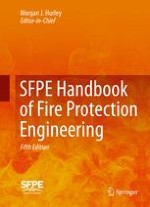2016 | OriginalPaper | Chapter
66. Fire Hazard Calculations for Large, Open Hydrocarbon Fires
Author : Craig L. Beyler
Published in: SFPE Handbook of Fire Protection Engineering
Publisher: Springer New York
Activate our intelligent search to find suitable subject content or patents.
Select sections of text to find matching patents with Artificial Intelligence. powered by
Select sections of text to find additional relevant content using AI-assisted search. powered by
